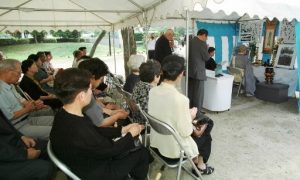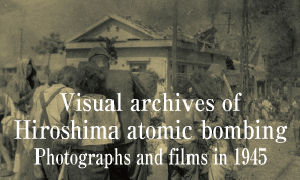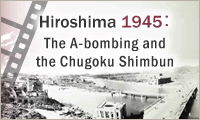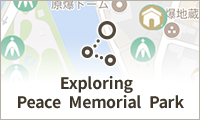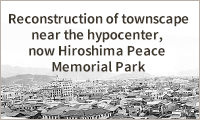Duty to pass down “that day” on A-bomb anniversary in 2000: Bereaved families hold joint memorial service to keep record of perished Motoyanagi-machi
Aug. 7, 2000
On August 6, the bereaved families of former residents of Motoyanagi-machi, a town completely wiped out by the atomic bomb, held a joint memorial service for the first time at the site of the town, which is now part of the Peace Memorial Park in Hiroshima’s Naka Ward. About 50 people attended the service, vowing to “continue to console the souls of the deceased and keep the record of the town in the 21st century.”
“Please forgive us for not being able to hold this memorial service for a long time,” said Ryozo Ueda, 84, the representative of an association made up of the former residents of Motoyanagi-machi. Mr. Ueda, who lives in Ebaminami 2-chome in Naka Ward, called on attendees to “pass on to future generations the tragedy of the town that was completely destroyed and realize world peace.” Ryoga Suwa, the 67-year-old chief priest who inherited Johoji Temple, formerly in Nakajima-honmachi (now part of Nakajima-cho in Naka Ward), a town next to Motoyanagi-machi, recited Buddhist sutras while all attendees offered incense for the deceased.
On the altar were displayed an aerial photograph taken before the atomic bombing, showing the Hiroshima branch of Morinaga Shokuryo Kogyo KK. (now Morinaga & Co., Ltd.) and about 40 houses lined up in a row, as well as panels of the Chugoku Shimbun article, “Records of Hiroshima: Photograph of Dead Speak,” which lists the circumstances of the deaths of 83 residents and 63 portraits of them.
Eijiro Motoue, 76, of Mikawa-cho in Naka Ward, lost five family members, including his parents and brothers. Mr. Motoue said: “I vividly remember my father saying, ‘Take care of yourself and do your best,’ as he pressed his face against the train window to see me off when I joined the army eight months before the atomic bombing. The memorial service being held at the place closely connected with my family was the best consolation for their souls.”
(Originally published on August 7, 2000)
“Please forgive us for not being able to hold this memorial service for a long time,” said Ryozo Ueda, 84, the representative of an association made up of the former residents of Motoyanagi-machi. Mr. Ueda, who lives in Ebaminami 2-chome in Naka Ward, called on attendees to “pass on to future generations the tragedy of the town that was completely destroyed and realize world peace.” Ryoga Suwa, the 67-year-old chief priest who inherited Johoji Temple, formerly in Nakajima-honmachi (now part of Nakajima-cho in Naka Ward), a town next to Motoyanagi-machi, recited Buddhist sutras while all attendees offered incense for the deceased.
On the altar were displayed an aerial photograph taken before the atomic bombing, showing the Hiroshima branch of Morinaga Shokuryo Kogyo KK. (now Morinaga & Co., Ltd.) and about 40 houses lined up in a row, as well as panels of the Chugoku Shimbun article, “Records of Hiroshima: Photograph of Dead Speak,” which lists the circumstances of the deaths of 83 residents and 63 portraits of them.
Eijiro Motoue, 76, of Mikawa-cho in Naka Ward, lost five family members, including his parents and brothers. Mr. Motoue said: “I vividly remember my father saying, ‘Take care of yourself and do your best,’ as he pressed his face against the train window to see me off when I joined the army eight months before the atomic bombing. The memorial service being held at the place closely connected with my family was the best consolation for their souls.”
(Originally published on August 7, 2000)

